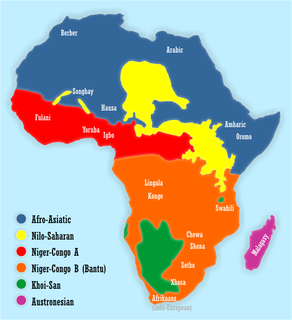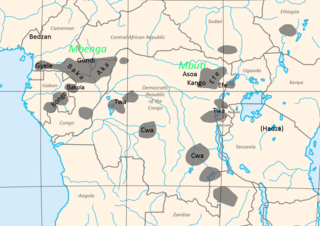Related Research Articles

The Bantu languages are a large family of languages spoken by the Bantu peoples in the southern half of Africa. They form the largest branch of the Southern Bantoid languages.

Niger-Congo is a hypothetical language family spoken over nearly the entirety of sub-Saharan Africa. It unites the Mande languages, the Atlantic-Congo languages, and possibly several smaller groups of languages that are difficult to classify. If valid, Niger-Congo would be the world's largest in terms of member languages, the third-largest in terms of speakers, and Africa's largest in terms of geographical area. It is generally considered to be the world's largest language family in terms of the number of distinct languages, just ahead of Austronesian, although this is complicated by the ambiguity about what constitutes a distinct language; the number of named Niger-Congo languages listed by Ethnologue is 1,540.
This article deals with the history of the country now called Zambia from prehistoric times to the present.
Shona is a Bantu language of the Shona people of Zimbabwe. It was codified by the colonial government in the 1950s. According to Ethnologue, Shona, comprising the Zezuru, Korekore and Karanga dialects, is spoken by about 7.5 million people. The Manyika and Ndau dialects of Shona are listed separately by Ethnologue, and are spoken by 1,025,000 and 2,380,000 people, respectively.

The Bantu expansion was a major series of migrations of the original Proto-Bantu-speaking group, which spread from an original nucleus around West-Central Africa across much of sub-Saharan Africa. In the process, the Proto-Bantu-speaking settlers displaced or absorbed pre-existing hunter-gatherer and pastoralist groups that they encountered.

Herero is a Bantu language spoken by the Herero and Mbanderu peoples in Namibia and Botswana, as well as by small communities of people in southwestern Angola. There were 211,700 speakers in 2014.
Zimba may refer to:
Gweno is a Bantu language spoken in the North Pare Mountains in the Kilimanjaro Region of Tanzania. The people known as the Gweno are a Chaga ethnic and linguistic group. Since the Chaga people are Bantu speakers, the adopted language contains dialects similar to that of the Kenyan language Kamba. Gweno shares about 54% to 56% of its vocabulary with other Chaga dialects and 46% with Taita dialects. However, a large percentage of its vocabulary is not seen in the other dialects. Also at the start of the 11th century, the Chaga people descended and migrated from the Bantu group in which they migrated to the foothills of mount Kilimanjaro. The Gweno language is today spoken mostly by older adults, with younger generations having shifted to Asu and Swahili. Ethnologue considers Gweno to be moribund; the language is not being passed down because children have not been exposed to Gweno since the 1970s. The generational shift from Gweno to either Asu or Swahili has certainly created shifts in dialect, however Gweno speakers do not see this as a threat.
Myene is a cluster of closely related Bantu varieties spoken in Gabon by about 46,000 people. It is perhaps the most divergent of the Narrow Bantu languages, though Nurse & Philippson (2003) place it in with the Tsogo languages (B.30). The more distinctive varieties are Mpongwe (Pongoué), Galwa (Galloa), and Nkomi.

The 250 or so "Narrow Bantu languages" are conventionally divided up into geographic zones first proposed by Malcolm Guthrie (1967–1971). These were assigned letters A–S and divided into decades ; individual languages were assigned unit numbers, and dialects further subdivided. This coding system has become the standard for identifying Bantu languages; it was the only practical way to distinguish many ambiguously named languages before the introduction of ISO 639-3 coding, and it continues to be widely used. Only Guthrie's Zone S is (sometimes) considered to be a genealogical group. Since Guthrie's time a Zone J has been set up as another possible genealogical group bordering the Great Lakes.
Tswa (Xitswa) is a South-Eastern Bantu language in Southern Mozambique. Its closest relatives are Ronga and Tsonga, the three forming the Tswa–Ronga family of languages.
Bantu may refer to:
Mbugwe or Mbuwe (Kimbugwe) is a Bantu language of spoken by the Mbugwe people of Lake Manyara in the Manyara Region of Central Tanzania. Mbugwe is estimated to be spoken by some 34,000 people.
The Zigula or Zigua language, Chizigua, is a Bantu language of Tanzania and Somalia, where it is known as Mushunguli (Mushungulu).

The Congo Pygmies are those "forest people" who have, or recently had, a hunter-gatherer economy and a simple, non-hierarchical societal structure based on bands, are of short stature, have a deep cultural and religious affinity with the Congo forest and live in a generally subservient relationship with agricultural "patrons", with which they trade forest products such as meat and honey for agricultural and iron products.

The Twa are a group of indigenous African Pygmy tribes.
Zemba (Dhimba) is a Bantu language spoken mainly in Angola where the language has about 18,000 speakers, and also in Namibia with some 4,000. It is closely related to Herero, and is often considered a dialect of that language, especially as the Zemba are ethnically Herero.
The Lega–Binja languages are part of the Bantu languages coded Zone D.20 in Guthrie's classification, specifically D.24–26, which according to Nurse & Philippson (2003) form a valid clade. According to Ethnologue, Bembe, which Nurse & Philippson were not sure belonged in its traditional group of D.50, is the closest language to Lega-Mwenga; Glottolog has it closest to Songoora. The resulting languages are:
Hakaona is a Bantu language of Angola and Namibia. Until perhaps Anita Pfouts (2003), it was considered a dialect of Herero.

Bantu people are the speakers of Bantu languages, comprising several hundred indigenous ethnic groups in Africa, spread over a vast area from Central Africa, to Southeast Africa, and to Southern Africa.
References
- ↑ Zimba at Ethnologue (18th ed., 2015)
- ↑ Jouni Filip Maho, 2009. New Updated Guthrie List Online
- ↑ Bryan, Margaret Arminel (Compiler), The Bantu Languages of Africa, Oxford University Press 1959.